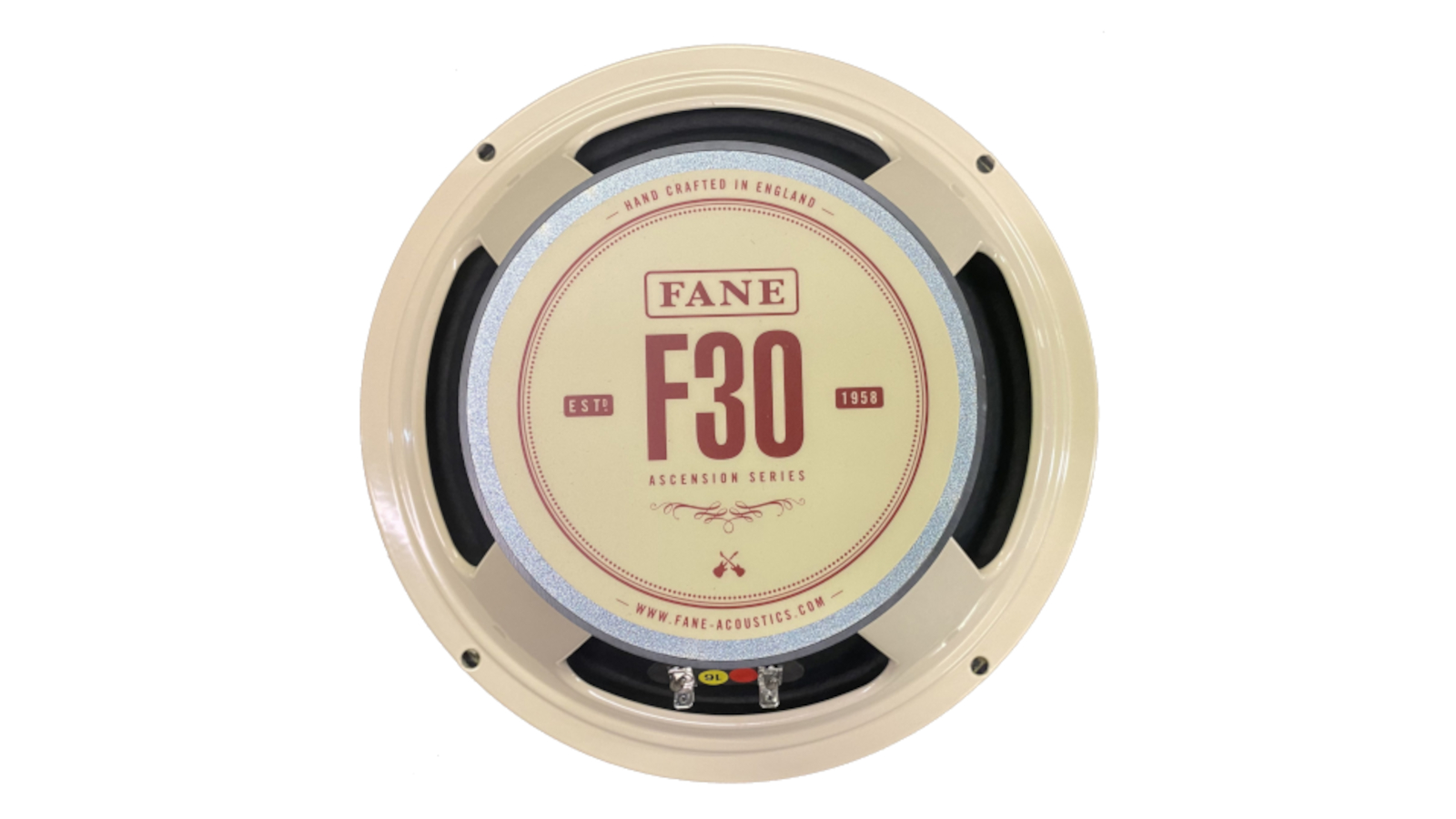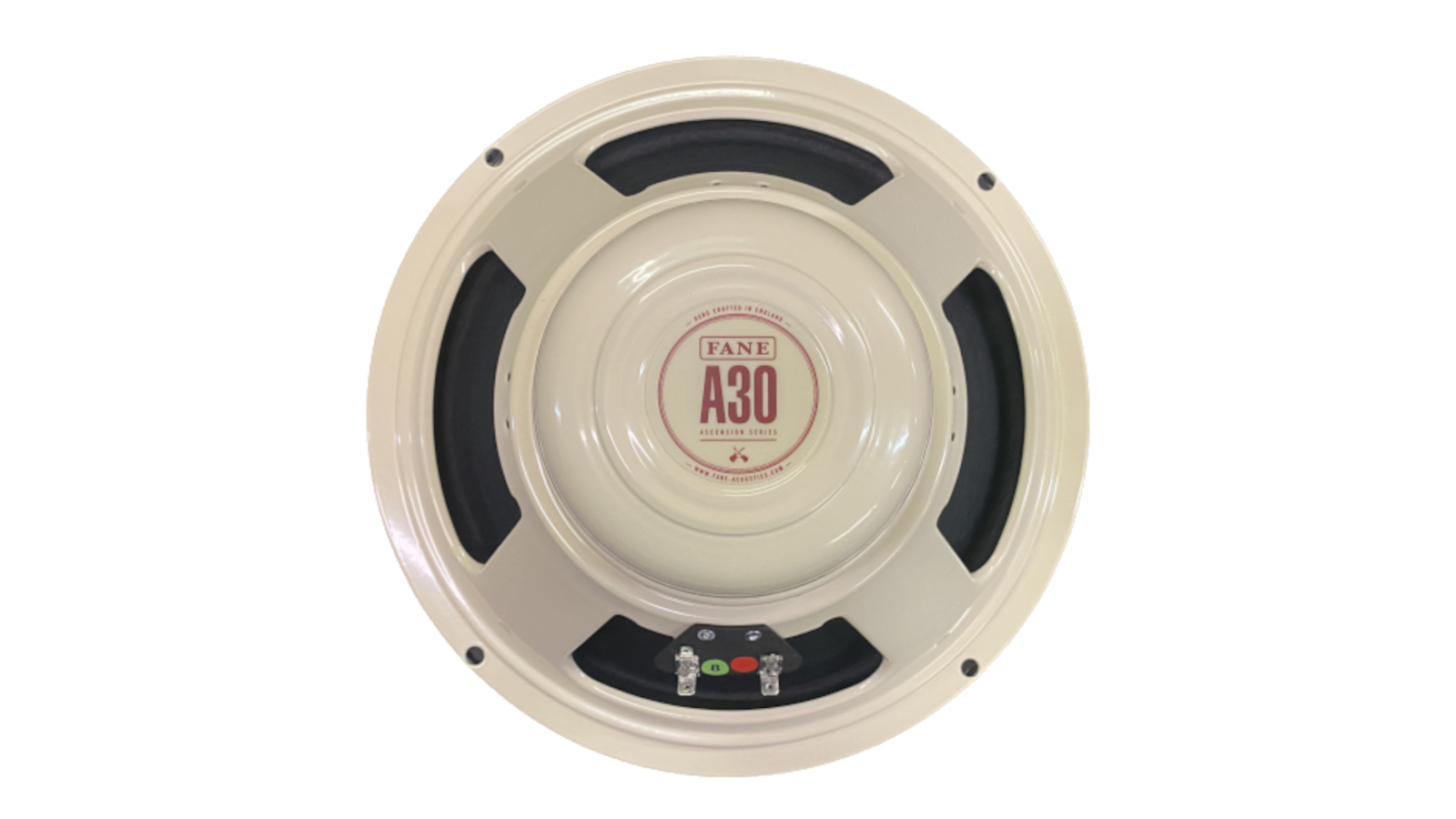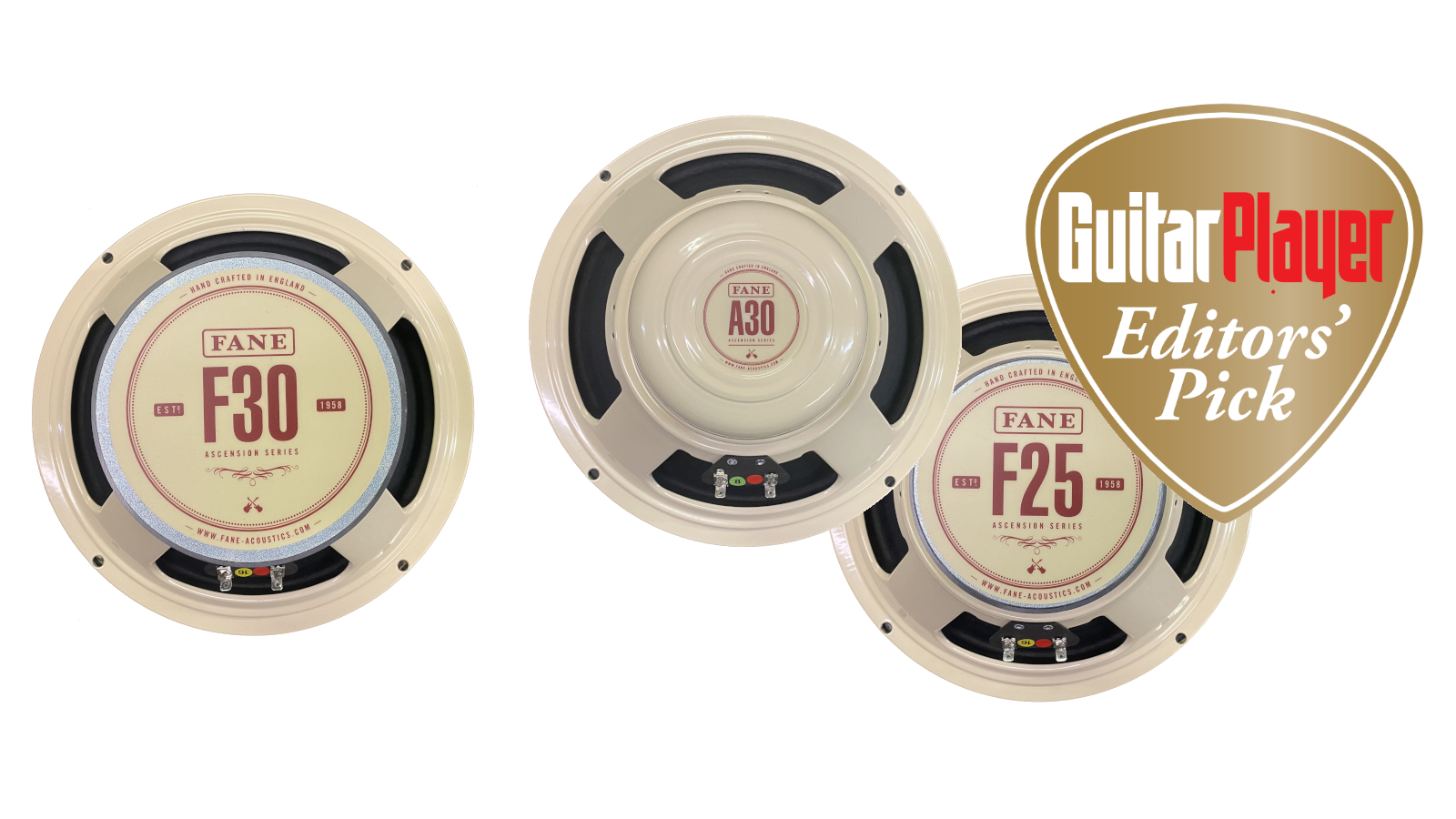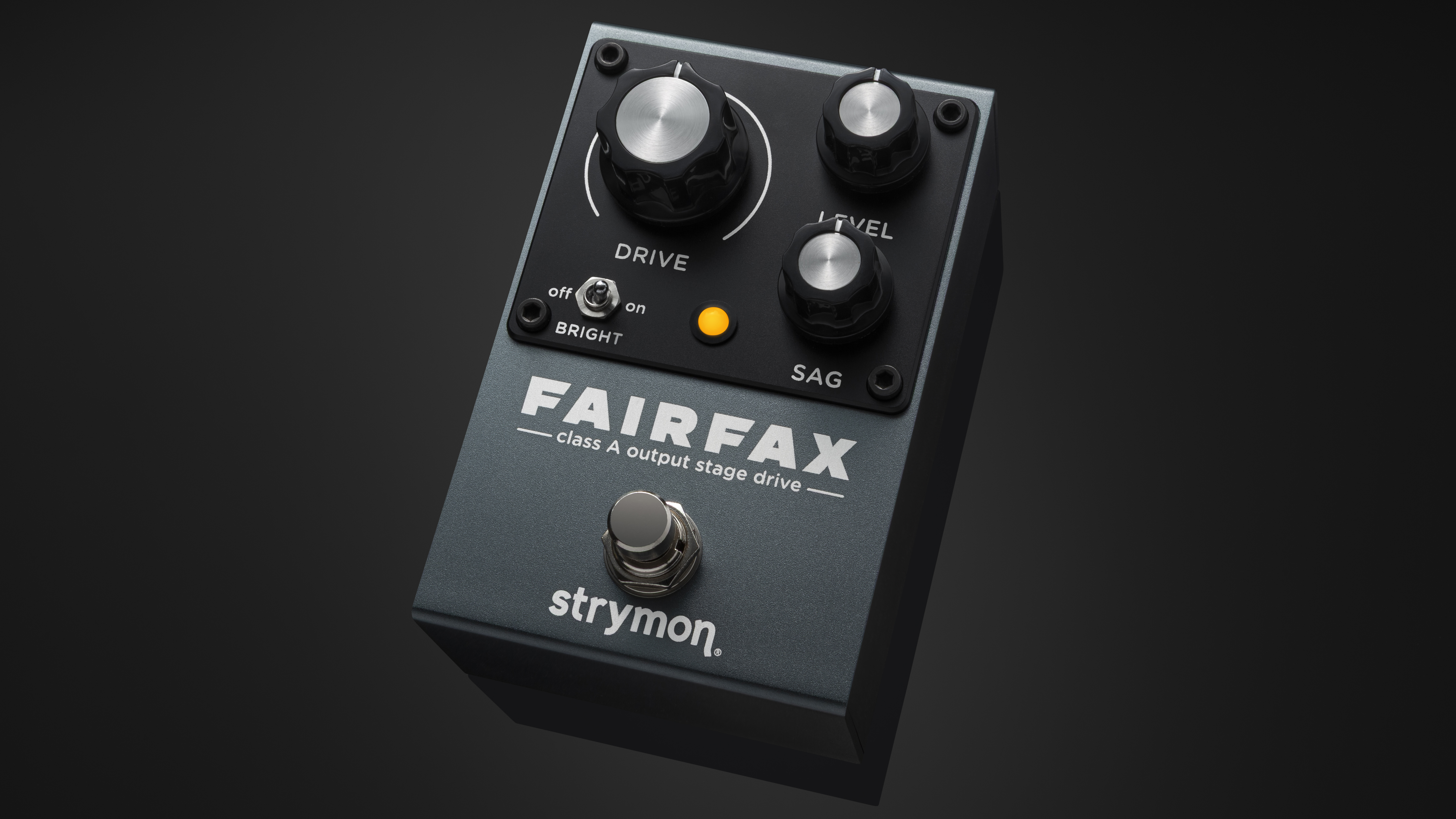GuitarPlayer Verdict
The F30 will help you cut through a muddy mix or give some guts to an underpowered amp. But the F25 and A30 deserve an Editors’ Pick Award for their classic Brit-voiced grind and sweet musicality, respectively.
Pros
- +
See below
Cons
- -
See below
You can trust Guitar Player.
Another company likely comes to mind first when “British speakers” are mentioned, one that has continued to proliferate on the market with several successful new and vintage-styled models.
However, plenty of discerning tonehounds will tell you that Fane, a lesser-known U.K. manufacturer, deserves far more acclaim than it’s often given, while attesting that the company’s speakers are among the best you can find, anywhere, and for any guitar-intended purpose.
Fane speakers were often the choice of powerful Hiwatt tube amps and cabs in the late ’60s and ’70s, and the company’s acclaimed Axiom series carried that reputation into the late ’90s and 2000s with models like the 100-watt AXA-12 Alnico.
In fact, more often than not, Fane designs have presented more robust and higher-power-handling speakers than the general run of electric guitar drivers inspired by the golden age of British amplification.
That was certainly the case with the Ascension F70 and A60 speakers that the company unveiled in the mid 2010s.
Now Fane has partnered once again with U.S. maker Avatar Speakers to expand the Ascension lineup with the F25, F30 and A30.
As their model numbers indicate, the two ceramic-magnet speakers and one Alnico follow the lower-power-handling template of other vintage-inspired models, aiming to deliver more pushed and detailed performances coupled to lower-powered amps, along with a dynamic and complex response when used in multiples to suit 50- and 100-watt rigs.
All the latest guitar news, interviews, lessons, reviews, deals and more, direct to your inbox!
Made in the U.K., all three are classy-looking, well-built speakers
Made in the U.K., all three are classy-looking, well-built speakers, with pressed-steel chassis, tidy cone mounting and doping, and high-quality multi-tab solder connections.
Note that the rims have only four mounting holes, preventing use in amps that use eight bolts without some modification.
I tested each in an open-back 1x12 pine cabinet powered by an AC15 for classic Vox chime, a Friedman Dirty Shirley Mini set for lower-powered Plexi-inspired tones, and a tweed-Deluxe style amp, using a Gibson Les Paul and a Fender Stratocaster.
ASCENSION F25

If you’re thinking the F25’s 35-ounce ceramic magnet, ribbed British cone, 25-watt power handling and 98dB sensitivity hint strongly at the Celestion Greenback, you’re correct, although this is no straight-up clone by any means.
However, the F25 does indeed seek to present that classic lighter-magnet delivery in a speaker that’s easily driven into juicy breakup, with a guitar-flattering midforward response and a softer low end that won’t threaten your bassist’s place in the mix.
In use, the F25 follows through on the premise, while proving that it’s far more than just a copy of the ubiquitous Greenback.
In addition to hitting the design touchstone sonically, the F25 is just a great-sounding all-round speaker
It gave a detailed and balanced performance, with a very classic-British character overall, particularly in that instantly identifiable warmer midrange and crackling high-end sizzle when hit with overdrive, although also with less of the overtly midforward haze that you get from many Greenback-inspired speakers.
Overall, I found it far less of a one-trick pony than that ubiquitous design often turns out to be, working surprisingly well with a broad variety of tones and playing styles.
It’s impressively good as a single unit – which isn’t always the case – with a very clear, musical presentation from clean amp settings, and dynamic pushed tones for crunchy power chords or leads.
In addition to hitting the design touchstone sonically, the F25 is just a great-sounding all-round speaker, and it is certainly one to consider if your amp isn’t putting out more than 15 or 20 watts.
ASCENSION F30

If you think you’re seeing a pattern emerging in the step up from F25 to F30, you’re likely on to something. This speaker’s bigger 60-ounce magnet, higher 100dB sensitivity and 30-watt power handling chases the traditional late ’60s and ’70s “heavy magnet” (a.k.a. “H”) speaker that was the punchier, more bass-heavy partner to the Greenback’s “M” magnet.
In use, the F30 delivers, too, with a tighter, crisper overall performance and a noticeably bigger low end.
This speaker is very articulate throughout its range, with a lot of immediacy and detail in a fast response that benefits swift picking, both clean and overdriven.
Another great speaker for the right application, and a high-quality rendition of its classic theme
There’s a little barkiness to the efficient F30, too, which really helps lead work cut through, but it can also give a slightly brittle impression with brighter amp settings, a characteristic that might lean it away from excelling in some Vox-styled amps.
Given the slightly scooped impression made by its bigger lows and more immediate highs, the F30 proved a surprisingly gutsy speaker for the Stratocaster, especially when bouncy SRV or fat Hendrix-like riffs were the aim.
And while +2dB might not sound like much in the efficiency department, it makes the F30 noticeably louder than the F25, an impression that’s further enhanced by the increased overall articulation and bigger bass response.
All told, it’s another great speaker for the right application, and a high-quality rendition of its classic theme.
ASCENSION A30

This is the one Alnico-magnet entrant amid the three newbies, and as such, both price and intentions set it somewhat apart from the F25 and F30.
The 35-ounce Alnico magnet delivers 100dB of efficiency with 30 watts of power handling, which should take us into famed Alnico Blue territory, specs-wise, in a speaker able to tolerate something like twice the power.
The result, it has to be said, is an extremely tasty-sounding speaker.
The A30 is sweet, articulate and loaded with the legendary chime that great Alnico speakers can deliver as a result of the slight softening of the compression, mixed with bountiful harmonic overtones and detailed sparkle in the highs.
Thrives in the middle, where its lush dimensionality, superb dynamics and lively shimmer help those “sweet spot” tones to truly shine
I also found it a great speaker for taking the bite and harshness out of an overly bright amp (approximated with some higher treble-control settings), yet without dulling or muting the high-frequency detail and extension in the least.
The A30’s clean and edge-of-breakup tones are particularly musical, with a lush juiciness that really benefited all three test amps, showing how well an ostensibly British-voiced speaker can work with, for example, a tweed Deluxe-style amp.
It also responded well to overdriven tones, enhancing a softer, more vintage-voiced edge amid the grind, and delivered plenty of lead-enhancing wail when pushed hard.
Really, though, it’s a speaker that thrives in the middle, where its lush dimensionality, superb dynamics and lively shimmer help those “sweet spot” tones to truly shine.
CONCLUSIONS
Each of these new Ascension models provides a great option for guitarists shopping in their respective markets, and should be given serious consideration alongside the usual suspects.
The F30 is a very able speaker, and one that will help you cut through a muddy mix or give some guts to an underpowered amp. But I found the F25 and A30 impressive for their classic Brit-voiced grind and sweet musicality, respectively, and each of these speakers is deserving of an Editors’ Pick Award.
If anything, I think I enjoyed these lower-powered Fanes even more than the higher-powered Ascensions released some seven years ago, and that’s really saying something.
SPECIFICATIONS
Ascension F25
- MAGNET: Ceramic, 35.27 oz
- POWER HANDLING: 25 watts
- RMS IMPEDANCE: 8Ω as tested (16Ω available)
- SENSITIVITY: 98dB
- FREQUENCY RANGE: 75Hz–5kHz
- VOICE COIL DIAMETER: 1.75”
- VOICE COIL FORMER: Paper
- WEIGHT: 7.83 lbs
- BUILT: England
For: A great take on the Greenback formula, enhancing classic-rock crunch and lead tones with added balance and articulation
Against: Be aware of its lower power handling when used singly, when it will also be just a little soft in the low end.
Ascension F30
- MAGNET: Ceramic, 60 oz
- POWER HANDLING: 30 watts RMS
- IMPEDANCE: 8Ω as tested (16Ω available)
- SENSITIVITY: 100dB
- FREQUENCY RANGE: 75Hz–5kHz
- VOICE COIL DIAMETER: 1.75”
- VOICE COIL FORMER: Paper
- WEIGHT: 10.69 lbs
- BUILT: England
For: A loud, punchy speaker with firm lows and a lively, detailed response overall
Against: Potentially a little shrill in bright-leaning amps
Ascension A30
- MAGNET: Alnico, 35.27 oz
- POWER HANDLING: 30 watts RMS
- IMPEDANCE: 8Ω as tested (16Ω available)
- SENSITIVITY: 100dB
- FREQUENCY RANGE: 75Hz–5kHz
- VOICE COIL DIAMETER: 1.75”
- VOICE COIL FORMER: Paper
- WEIGHT: 9.04 lbs
- BUILT: England
For: An extremely sweet, musical Alnico speaker that presents great clarity and harmonic sparkle, with plenty of volume
Against: At $265 it’s pricey… and you’ll want to watch your power handling
For more information visit Avatar Speakers.
Dave Hunter is a writer and consulting editor for Guitar Player magazine. His prolific output as author includes Fender 75 Years, The Guitar Amp Handbook, The British Amp Invasion, Ultimate Star Guitars, Guitar Effects Pedals, The Guitar Pickup Handbook, The Fender Telecaster and several other titles. Hunter is a former editor of The Guitar Magazine (UK), and a contributor to Vintage Guitar, Premier Guitar, The Connoisseur and other publications. A contributing essayist to the United States Library of Congress National Recording Preservation Board’s Permanent Archive, he lives in Kittery, ME, with his wife and their two children and fronts the bands A Different Engine and The Stereo Field.


